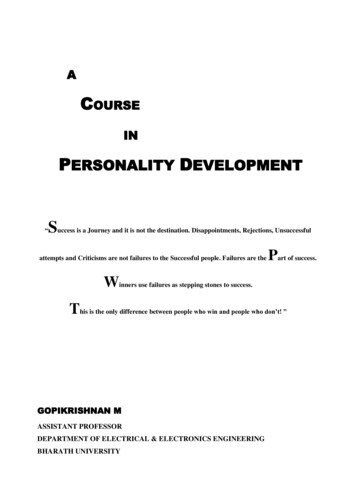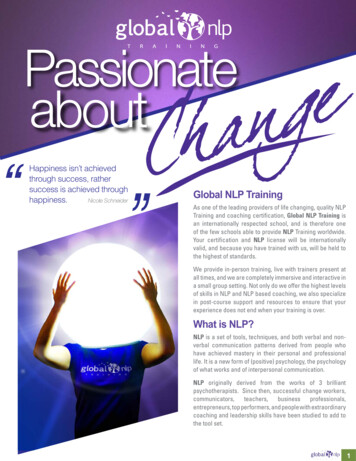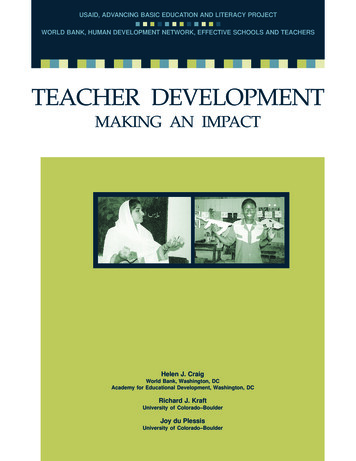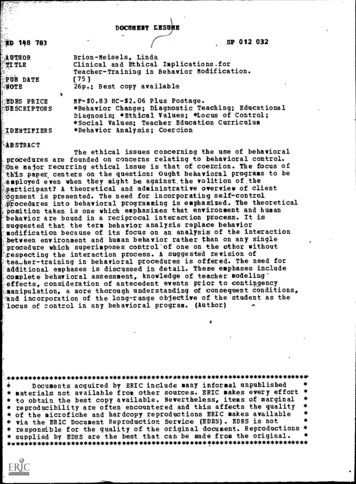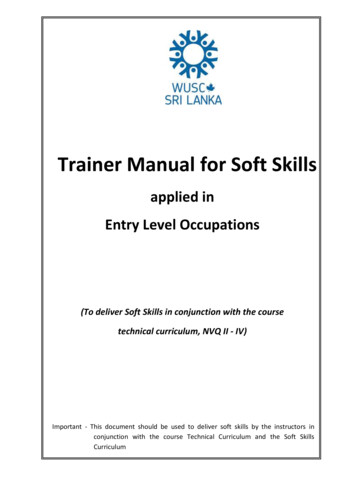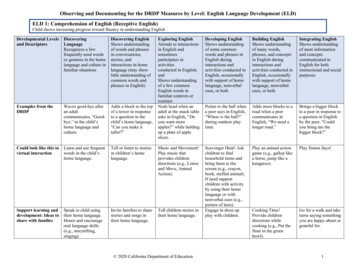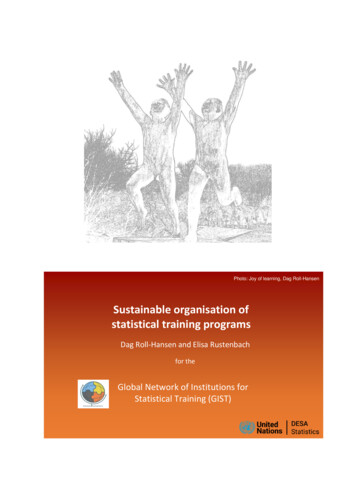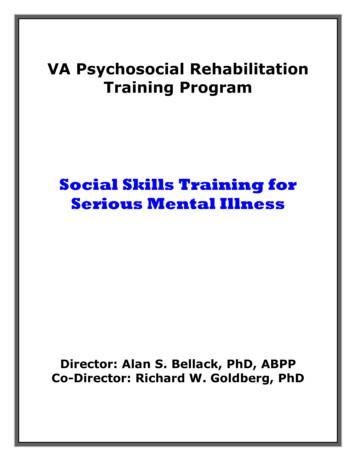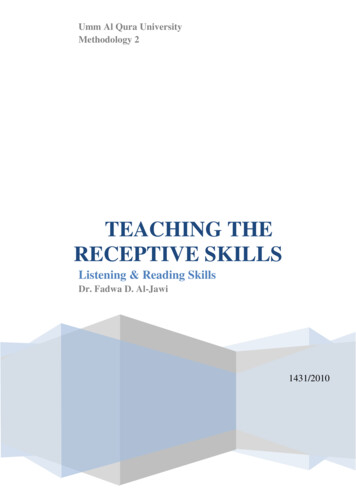
Transcription
Umm Al Qura UniversityMethodology 2TEACHING THERECEPTIVE SKILLSListening & Reading SkillsDr. Fadwa D. Al-Jawi1431/2010
Teaching English LanguageSkillsLanguage instruction includes four important skills. These skills are Listening, Speaking, Readingand Writing. The main reason for isolating these skills and discussing them separately is to highlight theirimportance and to impress upon the teachers to place emphasis on their teaching and deal with them in abalanced way. Some language skills are neglected during the classroom practice and hence they are giveninsufficient and inadequate exposure; Research shows that listening and speaking are nearly neglected andnot well recognized by' most EFL teachers in Saudi Arabia. These skills are largely considered as passiveskills.Language skills are divided into receptive arid productive ones. The receptive skills include listeningand reading while the productive ones are speaking and writing. Language skills could also be divided intoaural and graphic ones. The aural skills deal with listening and speaking ability while the graphic skills focuson reading and writing (see figure 1). Extensive exposure to receptive skills leads to the productive one.Wilkins (1984: 1 00) maintains that "the transfer of linguistic knowledge from receptive to productive isprobably a relatively slow process, but it does take place, as the study of language acquisition shows." Hence,a rich exposure to listening and reading is required to attain mastery and proficiency in natural production.Figure (1): differences between the aural and graphic skills 2
Part I: Teaching the Receptive SkillsReceptive skills are the ways in which people extract meaning from the discourse they see or hear.There are generalities about this kind of processing which apply to both reading and listening - and whichwill be addressed in this chapter - but there are also significant differences between reading and listeningprocesses too, and in the ways we can teach these skills in the classroom.How we read and listenWhen we read a story or a newspaper, listen to the news, or take part in conversation we employ ourprevious knowledge as we approach the process of comprehension, and we deploy a range of receptive skills;which ones we use will be determined by our reading or listening purpose.What a reader will bring to understand a piece of discourse is much more than just knowing thelanguage. In order to make sense of any text we need to have 'pre-existent knowledge of the world' (Cook1989: 69). Such knowledge is often referred to as schema (plural schemata). Each of us carries in our headsmental representations of typical situations that we come across. When we are stimulated by particular words,discourse patterns, or contexts, such schematic knowledge is activated and we are able to recognise what wesee or hear because it fits into patterns that we already know. As Chris Tribble points out, we recognise aletter of rejection or a letter offering a job within the first couple of lines (Tribble 1997: 35).have to work doubly hard to understand what they see or hear When we see a written text our schematicknowledge may first tell us what kind of text genre we are dealing with. Thus if we recognise an extract as coming from a novel we willhave expectations about the kind of text we are going to read. These will be different from the expectations aroused if we recognise apiece of text as coming from an instruction manual. Knowing what kind of a text we are dealing with allows us to predict the form it maytake at the text; paragraph, and sentence level. Key words and phrases alert us to the subject of a text, and this again allows us, as weread, to predict what is coming next. In conversation knowledge of typical interactions helps participants to communicate efficiently. Asthe conversation continues, the speakers and listeners draw upon various schemata -including genre, topic, discourse patterning, and theuse of specific language features - to help them make sense of what they are hearing. As with readers, such schemata arouse expectationswhich allow listeners to predict what will happen in the conversation. Such predictions give the interaction a far greater chance of successthan if the participants did not have such pre-existing knowledge to draw upon.Shared schemata make spoken and written communication efficient. Without the right kind of pre-existing knowledge,comprehension becomes much more difficult. And that is the problem for some foreign language learners who, because they have a different shared knowledge of cultural reference and discourse patterning in their own language and culture from that in the Englishvariety they are dealing with, have to work doubly hard to understand what they see or hear.Top-down and bottom-upA frequent distinction is made - especially in the analysis of reading - between top-down and bottomup processing. In metaphorical terms this can be likened to the difference between looking down onsomething from above - getting an overview - and, on the contrary, being in the middle of something andunderstanding where we are by concentrating on all the individual features. It is the difference betweenlooking at a forest, or studying the individual trees within it.It has been said that in top-down processing the reader or listener gets a general view of the readingor listening passage by, in some way, absorbing the overall picture: This is greatly helped if the reader orlistener's schemata allow them to have appropriate expectations of what they are going to come across. Inbottom-up processing, on the other hand, the reader or listener focuses on individual words and phrases, andachieves understanding by stringing these detailed elements together to build up a whole.It is probably most useful to see acts of reading and listening as interactions between top-down andbottom-up processing. Sometimes it is the individual details that help us understand the whole; sometimes itis our overview that allows us to process the details. Without a good understanding of a reasonable proportion- of the details gained through some bottom-up processing we will be unable to get any clear general pictureof what the text is about. A non-scientist attempting to read a specialist science journal finds this to be thecase almost immediately. A person listening to a conversation in a foreign language with many words he orshe does not know finds bottom-up and top-down processing almost impossible.Reasons for reading and listeningWhen we read a sign on the motorway our motives are different from when we read a detectivenovel; when we take an audiotape guide round a museum we have a different purpose in mind from when welisten to a stranger giving us directions on a street corner. We can divide reasons for reading and listening intotwo broad categories:1 For maintaining good social relationsWe often hear people say they spent a whole afternoon or whole weekend chatting with someone elsebut when they are asked what they talked about, they say things like, 'Nothing much!' or 'I can't reallyremember.' In this kind of talk, the information content or message is not important. What is important is the 3
goodwill that is maintained or established through the talk. The communication here is listener-oriented andnot message-oriented. A great deal of conversation and casual talk is of this nature.2 For entertainmentPeople listen to jokes, stories, songs, plays, TV; radio broadcasts, etc. mainly for entertainment. Theoutcome of such listening is not usually measured in terms of how useful it was but in terms of personalsatisfaction.3 For obtaining information necessary for day-to-day livinga large amount of reading and listening takes place because it will help us to achieve some clear aim.Thus, for example, we read a road sign so that we know where to go. People listen to news broadcasts,directions on how to get to different places, weather forecasts and travel : information-airport, bus- and trainterminal announcements-because listening to these enables them to get the information necessary for day-today living: to know when to board the plane, whether it is 'safe' to plan a picnic, etc.4 For academic purposesPeople listen to lectures, seminars and talks as a way of extending their knowledge and skills.Listening is a central part of all learning. A pupil who cannot understand what the teacher is saying in a classis seriously hampered in his learning.Different sub- skills of listening and readingThe processes we go through when reading a novel or listening to a poem are likely to be differentfrom those we use when we are looking for someone's number in a telephone directory, or when we arelistening to a spoken 'alert' message on a computer. Our use of these different skills will frequently depend onwhat we are reading or listening for. Identifying the topic: good readers and listeners are able to pick up the topic of a written or spokentext very quickly. With the help of their own schemata they quickly get an idea of what is being talked about.This ability allows them to process the text more effectively as it progresses. Predicting and guessing: both readers and listeners sometimes guess in order to try and understandwhat is being written or talked about, especially if they have first identified the topic. Sometimes they lookforward, trying to predict what is coming; sometimes they make assumptions or guess the content from theirinitial glance or half-hearing - as they try and apply their schemata to what is in front of them. Theirsubsequent reading and listening helps them to confirm their expectations of what they have predicted or toreadjust what they thought was going to happen in the Light of experience. . Reading and listening for general understanding: good readers and listeners are able to take in astream of discourse and understand the gist of it without worrying too much about the details. Reading andlistening for such 'general' comprehension means not stopping for every word, not analysing everything thatthe writer or speaker includes in the text. A term commonly used in discussions about reading is skimming(which means running your eyes over a text to get a quick idea of the gist of a text). By encouraging studentsto have a quick look at the text before plunging into it for detail, we help them to get a general understandingof what it is all about. This will help them when and if they read for more specific information. Gist readingand listening are not 'lazy' options. The reader or listener has made a choice not to attend to every detail, butto use their processing powers to get more of a top-down view of what is going on. Reading and listening for specific information: in contrast to reading and listening for gist, wefrequently go to written and spoken text because we want specific details; we may listen to the news, onlyconcentrating when the particular item that interests us comes up. We may quickly look through a film reviewto find the name of the director or the star. In both cases we almost ignore all the other information until wecome to the specific item we are looking for. In discussions about reading this skill is frequently referred to asscanning. Reading and listening for detailed information: sometimes we read and listen in order tounderstand everything we are reading in detail. This is usually the case with written instructions or directions,or with the description of scientific procedures; it happens when someone gives us their address andtelephone number and we write down all the details. If we are in an airport and an announcement starts withHere is an announcement for passengers on flight AA671 to Lima (and if that is where we are going), welisten in a concentrated way to everything that is said. Interpreting text: readers and listeners are able to see beyond the literal meaning of words in apassage, using a variety of clues to understand what the writer or speaker is implying or suggesting.Successful interpretation of this kind depends to a large extent on shared schemata as in the example of thelecturer who, by saying to a student You're in a non-smoking zone was understood to be asking the student toput her cigarette out. We get a lot more from a reading suggest because, as active participants, we use ourschemata together with our knowledge of the world to expand the pictures we have been given, and to fill inthe gaps which the writer or speaker seems to have left. or listening text than the words alone 4
Problems and solutionsThe teaching and learning of receptive skills presents a number of particular, problems which willneed to be addressed. These are to do-with language, topic, the tasks students are asked to perform, and theexpectations they have of reading and listening, as we shall discuss below.1- LanguageWhat is it that makes a text difficult? In the case of written text some researchers look at word andsentence-length (Wallace-1992: 7), on the premise that texts with longer sentences and longer words will bemore difficult to understand than those with shorter ones. Others, however, claim that the critical issue isquite simply the number of unfamiliar words which the text contains. If readers and listeners do not know allthe words in a text, they will have great difficulty in understanding the text as a whole. To be successful theyhave to recognize a high potion of the vocabulary without consciously thinking about it (Paran 1996). It isclear that both sentence length and the percentage of unknown words both play their part in a text'scomprehensibility.When students who are engaged in listening encounter unknown lexis it can be 'like a dropped barriercausing them to stop and think about the meaning of a word and thus making them miss the next part of thespeech" (Underwood 1989:17). Unlike reading, there may be no opportunity to go back and listen to the lexisagain. Comprehension is gradually degraded, therefore, and unless the listener is able to latch on to a newelement to help them back into the flow of what is being said the danger is that they will lose heart andgradually disengage from the receptive task since it is just too difficult.Apart from the obvious point that the more language we expose students to the more they will learn,there are specific ways of addressing the problem of language difficulty: pre-teaching vocabulary, usingextensive reading listening, and considering alternatives to authentic language. Pre-teaching vocabulary: one way of helping students is to pre- teach vocabulary that is in thereading or listening text. This removes at least some of the barriers to understanding which they are likely toencounter. However, if we want to give students practice in what it is like to tackle authentic reading andlistening texts for general understanding then getting past words they do not understand is one of the skillsthey need to develop. By giving them some or all of those words we deny them that chance. We need acommon-sense solution to this dilemma. Where students are 'likely to be held back unnecessarily because ofthree or four words, it makes sense to teach them first. Where they should be able to comprehend the textdespite some unknown words, we can leave vocabulary work till later.An appropriate compromise is to use some (possibly unknown) words from a reading or listening textas part of our procedure to create interest and activate the students' schemata, since the words may suggesttopic, genre, or construction - or all three. The students can first research the meanings of words and phrasesand then predict what a text with such words is likely to be about. Extensive reading and listening: most researchers like to make a difference between 'extensive'and 'intensive' reading and listening. Look at the differences in the next section.The benefits of extensive reading are echoed by the benefits for extensive listening: the more studentslisten, the more language they acquire, and the better they get at listening activities in general. Whether theychoose passages from textbooks, recordings of simplified readers, listening material designed for their level,or recordings of radio programmes which they are capable of following, the effect will be the same. Providedthe input is comprehensible they will gradually acquire more words and greater schematic knowledge whichwill, in turn, resolve many of the language difficulties they started out with. Authenticity: because it is vital for students to get practice in dealing with written text and speechwhere they miss quite a few words but are still able to extract the general meaning, an argument can be madefor using mainly authentic reading and listening texts in class. After all, it is when students come into contactwith 'real' language that they have to work hardest to understand.Authentic material is language where no concessions are made to foreign speakers. It is normal,natural language used by native - or competent - speakers of a language. This is what our students encounter(or will encounter) in real life if they come into contact with target-language speakers, and, precisely becauseit is authentic, it is unlikely to be simplified, spoken slowly, or to be full of simplistic content (as sometextbook language has a tendency to be). Authentic material which has been carelessly chosen can beextremely de-motivating for students since they will not understand it. Instead of encouraging such failure,therefore, we should let students read and listen to things they can understand. For beginners this may meanroughly tuned language from the teacher and specially designed reading and listening texts from materialswriters. However, it is essential that such listening texts approximate to authentic language use. The languagemay be simplified, but it must not be unnatural.It is worth pointing out that deciding what is or is not authentic is not easy. The language whichstudents are exposed to has just as strong claim to authenticity as the play or the parent, provided that it is not 5
altered in such a way as to make it unrecognisable in style and construction from the language which nativespeakers encounter in many walks of life.2- Topic and genreMany receptive skill activities prove less successful than anticipated because the topic is notappropriate or because students are not familiar with the genre they are dealing with. If students are notinterested in a topic, or if they are unfamiliar with the text genre we are asking them to work on, they may bereluctant to engage fully with the activity. Their lack of engagement or schematic knowledge may be a majorhindrance to successful reading or listening. To resolve such problems we need to think about how we chooseand use topics, and how we approach different reading and speaking genres: . Choose the right topics: we should try and choose topics which our students will be interested in.We can find this out by questionnaires, interviews, or by the reactions of students in both current andprevious classes to various activities and topics we have used'. However, individual students have individualinterests, so that it is unlikely that all members of a class will be interested in the same things. For 'this reasonwe need to include-a variety of topics across a series of lessons so that all our students' interests will becatered for in the end. Create interest: if we can get the students engaged in the task there is a much better chance thatthey will read or listen with commitment and concentration, whether or not they were interested in the topicto start with. We can get students engaged by talking about the topic, by showing a picture for prediction, byasking them to guess what they are going to see or hear on the basis of a few words or phrases from the text,or by having them look at headlines or captions before they read the whole thing. Perhaps we will show thema picture of someone famous and get them to say if they know anything about that person before they read atext about them or hear them talking. Activate schemata: in the same way we create interest by giving students predictive tasks andinteresting activities, we want to activate their knowledge before they read or listen so that they bring theirschemata to the text. Vary topics and genres: a way of countering student unfamiliarity with certain written and spokengenres is to make sure we expose them to a variety of different text types, from written instructions and tapedannouncements to stories in books and live, spontaneous conversation, from Internet pages to business letters,from pre-recorded messages on phone lines to radio dramas.In good general English course books a number of different genres are ' represented in both readingand listening activities. If the teacher is not following a course book, however, then it is a good idea to make alist of text genres which are relevant to the students' needs and interests in order to be sure that they willexperience an appropriate range of texts. Ensuring students' confidence with more than one genre becomesvitally important, too, in the teaching of productive skills.3- Comprehension tasksA key feature in the successful teaching of receptive skills concerns the choice of comprehensiontasks. Sometimes such tasks appear to be testing the students rather than helping them to understand.Although reading and listening are perfectly proper mediums for language and skill testing, nevertheless, ifwe are trying to encourage students to improve their receptive skills, testing them will not be an appropriateway of accomplishing this. Sometimes texts or the tasks which accompany them are far too easy or far toodifficult. In order to resolve these problems we need to use comprehension tasks which promoteunderstanding and we need to match text and task appropriately. Testing and teaching: the best kinds of tasks are those which raise students' expectations, helpthem tease out meanings, and provoke an examination of the reading or listening passage. Unlike reading andlistening tests, these tasks bring them to a greater understanding of language and text construction. By havingstudents perform activities such as looking up information on the Internet, filling in forms on the basis of alistening tape, or solving reading puzzles, we are helping them become better readers and listeners,Some tasks seem to fall half way between testing and teaching, however, -since-by-appearing-to ademand right answer (for example, by asking if certain statements about the text are true or false, or byasking questions about the text with what, when, how many, and how often) they could, in theory, be used toassess student performance. Indeed when they are done under test conditions, their purpose is obviously toexplore student strengths and weaknesses. Yet such comprehension items can also be an indispensable part ofa teacher's receptive skills armoury too. By the simple expedient of having students work in pairs to agree onwhether a statement about part of a text is true or false - or as a result of a discussion between the teacher andthe class - the comprehension items help each individual (through conversation and comparison) tounderstand something, rather than challenging them to give right answers under test-like conditions. Ifstudents predict the answers to such questions before they read or listen, expectations are created in theirminds to help them focus their reading or listening. In both cases we have turned a potential test task into acreative tool for receptive skill training. 6
Whatever the reading task, in other words, a lot will depend on the conditions in which students areasked to perform that task. Even the most formal test-like items can be used to help students rather thanfrighten them! Appropriate challenge: when asking students to read and listen we want to avoid texts and tasksthat are either far too easy or far too difficult. As with many other language tasks we want to get the level ofchallenge right, to make the tasks 'difficult but achievable' (Scrivener 1994b: 149).Getting the level right depends on the right match between text and task. Thus, where a text isdifficult, we may still be able to use it, but only if the task is appropriate. We could theoretically, for example,have beginners listen to the famous soliloquy from Shakespeare's Hamlet (To be or not to be? /That is thequestion./Whether 'tis nobler . , etc) and ask them how many people are speaking. Yet we might feel thatneither is appropriate or useful. On the other hand, having students listen to a news broadcast where thelanguage level is very challenging, may be entirely appropriate if the task only asks them at first - to try andidentify the five main topics in the broadcast.4- Negative expectationsStudents sometimes have low expectations of reading and listening. They can feel that they are notgoing to understand the passage in the book or on tape because it is bound to be too difficult, and they predictthat the whole experience will be frustrating and de-motivating. Where students have low expectations ofreading and listening (and of course not all students do) it will be our job to persuade them, through ouractions, to change these negative expectations into realistic optimism. Manufacturing success: by getting the level of challenge right (in terms of language, text, andtasks) we can ensure that students are successful. By giving students a clear and achievable purpose, we canhelp them to achieve that purpose. Each time we offer them a challenging text which we help them to read orlisten to successfully, we dilute the negative effect of past experiences, and create ideal conditions for futureengagement. Agreeing on a purpose: it is important for teacher and students to agree on both general andspecific purposes for their reading or listening. Are the students trying to discover detailed information or justget a general understanding of what something is about? Perhaps they are listening to find out the time of thenext train; maybe they are reading in order to discern only whether a writer approves of the person they aredescribing. If students know why they are reading or listening they can choose how to approach the text. Ifthey understand the purpose they will have a better chance of knowing how well they have achieved it. 7
First section: Teaching ListeningAims of Teaching ListeningThe component on listening aims at developing pupils' ability to listen to information with understanding and precision. The sub-skills of listening range from the basic level of sound, word and phraserecognition to an understanding of the whole text. The use of various text types is recommended ranging fromteacher- simulated texts to media broadcasts and authentic conversations.Pupils are encouraged to respond to the in- formation heard in a variety of ways. These responseswould comprise both verbal and non-verbal forms. By the end of the primary school, pupils should be able tolisten to and respond to a number of familiar topics. Thus, the sub-skills of listening extend and develop skillsof understanding the text and responding to the message in the text as well as to non-verbal cues conveyedwithin the communication.Processes Involved in Listening1 Hearing vs. listeningOur ears are constantly being barraged by sound. However, we do not pay attention to everything wehear. We only begin to 'listen' when we pay attention to the sounds we hear and make efforts to interpretthem.2 Top-down processingWhen a listener hears something, this may remind him of something in his previous knowledge, andthis in turns, leads him to predict the kind of information he is likely to hear. When this happens, he is said tobe using 'top-down' processing. When a listener can relate what he is about to hear he already knows, this willhelp him understand what he hears better. This is why pre-listening activities are introduced to help studentssee how the listening text relates to what they already know.3 Bottom-up processingIf what he hears does not trigger anything in the previous knowledge, then the listener would resort towhat is called 'bottom up' listening, the slow building up of meaning block by block through understandingall the linguistic data he hears. This kind of processing is much hard way to solve this problem, however, isnot to focus the student's attention on the 'building blocks': pronunciation, word knowledge, etc. People listenfor words and sounds. They listen for meaning. So you should teach your students to list meaning: to usewhatever clues they can get from the context-who is speaking, .on what topic, for what purpose, to whom,where, etc.-to make sense of what they hear. They should, for example, try to guess the meaning of unknownor partially heard words from the context. They should be taught to have a whole-to-part focus in theirlistening. They should work at understanding the whole message and to use grammar, vocabulary and soundsonly as aids in doing this and not as important in themselves.4- Listening is an active processWhen a proficient listener listens, he doesn't passively receive what the speaker says. He activelyconstructs meaning. He identifies main points and supporting details; he distinguishes fact from opinion. Heguesses the meaning of unfamiliar words. These are cognitive aspects of listening. There are also affective oremotional dimensions to listening. The listener agrees or disagrees with a speaker. Likes or dislikes thespeaker's tone of voice or choice of words. He may find the speakers' choice of topic morally objectionable orabsolutely boring. He may be disappointed with/surprised by/worried about satisfied with the speaker'streatment of the topic and so on. Listeners' attitudes, values and interests all affect the way they interpret andrespondDifferences Between Extensive And Intensive L
The receptive skills include listening and reading while the productive ones are speaking and writing. Language skills could also be divided into aural and graphic ones. The aural skills dea
